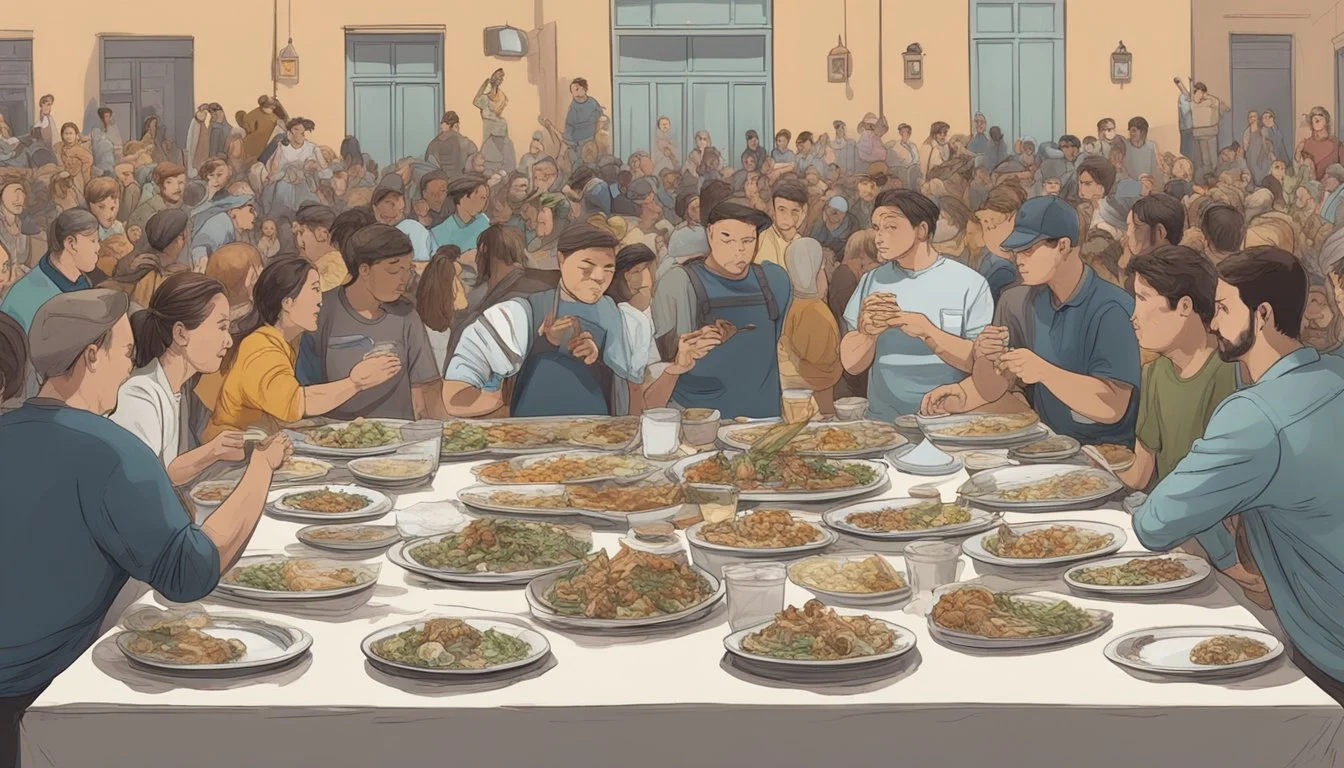Connecticut Food Challenges
Ultimate Tests for Local Foodies
Connecticut offers a diverse and exciting range of food challenges that cater to those with hearty appetites and a competitive spirit. These contests are not just about devouring massive portions but also bring food enthusiasts together to test their limits, understanding of strategies, and endurance. In Connecticut, these events take place in various restaurants and food joints, inviting both local and visiting challengers to take on colossal burgers, towering stacks of pancakes, or fiery wings that set taste buds ablaze.
With a variety of challenges available, competitors can push the boundaries of their culinary comfort zones. Some food challenges require participants to finish enormous servings under a time limit to win prizes, such as cash or a place on the coveted wall of fame. This sense of awareness and community involvement is often present at these events, as spectators gather to watch participants tackle what seems insurmountable. For those interested in scouting potential challenges, resources like FoodChallenges.com help locate available contests across the state.
Each food challenge in Connecticut has a unique set of rules and rewards, fostering an environment where knowledge of one's own capabilities is just as important as an appetite for fun and adventure. Whether the aim is to set a new record or simply enjoy the experience, Connecticut's food challenges offer a unique way to engage with the state's food culture and create lasting memories.
Food Challenge Fundamentals
Food Challenges in Connecticut offer a diverse culinary playground for the brave and the hungry, with regional traditions and eateries adding their unique twist to these gastronomical feats.
Defining Food Challenges
Food challenges are competitive eating events where participants attempt to consume large quantities of food within a specified period. The challenges often involve local favorites and can range from towering burgers to colossal ice cream sundaes, designed to test the limits of one's appetite and speed.
History of Food Challenges in Connecticut
In Connecticut, food challenges have woven themselves into the state’s fabric, dating back to local fairs and community events where feats of consumption were celebrated. They have evolved from informal contests to well-organized competitions found in restaurants across the state.
Types of Food Challenges
Connecticut's food challenges can be categorized based on the type of food and the structure of the challenge:
By Food Type:
Eggs: Morning challenges where heaps of scrambled eggs must be cleared.
Meat: Barbecue and burger challenges dominate, with pounds of meat to be devoured.
Breakfast: Large-scale breakfast platters that are a race against the clock.
By Participant:
Children: Family-friendly eateries offer smaller-scaled contests suited for young challengers.
Family: Group challenges that encourage teamwork to tackle the enormous portions.
By Objective:
Record Setting: Challenges that exist to break records for the fastest or most consumed.
Charity Events: Eating for a cause, where participation and completion benefit local charities.
Health and Safety Considerations
When addressing health and safety in food challenges, it's critical to consider both the immediate potential dangers and the long-term impact on participants. Establishing clear guidelines and promoting health-conscious competition can mitigate risks and enhance participant awareness.
Potential Dangers
Dangerous situations can arise from food challenges, such as choking hazards or allergic reactions. Unhealthy habits may also develop, potentially promoting obesity if challenges encourage overconsumption. It is essential for organizers to recognize these risks and for a judge or supervising authority to be present, equipped to handle emergencies.
Promoting Healthy Competition
Competition should be structured in a way that prioritizes safety and health. For example, competitions can include nutritious foods or limit portion sizes to discourage overeating. Awareness campaigns about the dangers of competitive eating are also beneficial, emphasizing that food challenges can be enjoyable without being unhealthy.
Guidelines for Participants
Participants should be informed of the following guidelines:
Pre-Screening: Ensure no existing health conditions could be exacerbated by the challenge.
Clear Instructions: Provide concise, clear instructions on the rules and expectations.
Moderation: Emphasize the importance of moderation, even in a competitive setting.
Safe Environment: Guarantee that the event space meets all safety standards.
By adhering to these strategies, food challenges can be conducted with a focus on health and safety, making them enjoyable and responsible events.
Popular Connecticut Food Challenges
Connecticut offers several captivating food challenges, each providing an opportunity for competitors to test their limits and potentially earn a place on the coveted wall of fame or win other exciting prizes.
That Breakfast Place Challenge
In Willimantic, That Breakfast Place hosts an enticing breakfast challenge that captures the hearts of breakfast enthusiasts. Contestants must navigate a hefty platter of eggs, pancakes, meats, and more. Success can lead to local recognition and brimming satisfaction from conquering one of the state's most famous morning feasts.
The Big Chicken Challenge
The Big Chicken Challenge is a formidable foe for poultry aficionados in Connecticut. Participants are tasked with consuming an enormous amount of chicken within a specific time frame, pushing both their limits and love for the bird to the extreme. The prize for those who prevail often includes cash or meal vouchers, solidifying their poultry prowess.
Extreme Steak Out
For meat lovers, the Extreme Steak Out presents a herculean task of steak consumption. This formidable challenge is designed for only the most voracious carnivores, as it requires the skills of speed, strategy, and stomach capacity to defeat. Attendees who emerge victorious from the Extreme Steak Out are not just full, but often find themselves with their names etched into the annals of Connecticut's competitive eating legends.
Cultural and Economic Impact
The cultural and economic impact of food challenges in Connecticut spans from the prosperity of local agriculture to the community bonds formed through food-based activities. This section delves into the specifics of how food challenges affect local businesses, tourism, and community building within the state.
Local Businesses and Food Challenges
Local businesses in Connecticut face unique food challenges, impacting both their economic stability and cultural significance. Miscellaneous crops, floriculture, and dairy products are among the highest valued commodities produced in the state, demonstrating an economy reliant on a diverse agricultural sector. Yet, they must navigate fluctuations in food insecurity rates, which have varied throughout the counties, influencing both supply demands and consumer purchasing power.
Impact on Tourism
Connecticut's cuisine and food challenges serve as a significant draw for tourists, bringing in visitors keen to experience the state's culinary diversity and agricultural heritage. Special food events and challenges can spark tourism, as they offer authentic experiences tied to the regional flavors and cooking traditions. This, in turn, bolsters local economies and showcases Connecticut's food products on a broader stage.
Food Challenges and Community Building
Food challenges in Connecticut also play a pivotal role in community building, fostering inclusivity and cultural exchange among diverse populations. Events centered on food unite people from varying backgrounds and can be particularly impactful in areas with higher insecurity prevalence, such as among certain ethnic groups. Engaging in community food experiences helps to strengthen social ties and promotes a collective identity within the state.
Criticism and Controversy
Connecticut's food challenges have increasingly come under scrutiny, with criticisms highlighting the perceived wasteful and gluttonous nature of these events. Critics also point to the role of social media in amplifying these contests, noting a concerning trend toward valuing views over social responsibility.
Arguments Against Food Challenges
Critics argue that food challenges are inherently wasteful. They maintain that while such competitions are often established to drive business or create buzz, especially on platforms like YouTube, they simultaneously fail to account for the sheer volume of food that goes unconsumed. They see these challenges not as celebrations of culinary prowess, but as displays of excess in a world where food insecurity persists.
Addressing Waste and Gluttony
The accusation of gluttony in food challenges is a major point of contention. Opponents claim that these contests promote a culture of overindulgence, which stands in stark contrast to ongoing efforts to combat food waste and promote sustainable consumption. Such challenges are often cited as examples of ignorance to the environmental and social impacts of food overproduction and wastefulness.
The Role of Social Media
Social media platforms, particularly YouTube, have been instrumental in bringing food challenges into the public eye, attracting thousands of views and creating a subculture of competitive eating. While some see this as harmless entertainment, others criticize it for glorifying behaviors that are both wasteful and potentially unhealthy. The concern is not just about the immediate impact but also about the long-term implications these portrayals of food may have on viewers, especially younger audiences.
Food Challenges and Social Responsibility
In Connecticut, addressing food challenges involves a collective effort from the community towards social responsibility. Specifically, there is a pressing need to direct resources such as nutritious food to children and families in need, particularly following the hardships brought on by the pandemic.
Encouraging Food Donations
Community members are urged to donate surplus food items, like fresh fruits and vegetables, to help alleviate hunger. Effective assistance can be measured in pounds of food collected, as significant quantities of donations, including staples like milk and pasta, are distributed through channels like SNAP and WIC programs. Churches and other community organizations play a pivotal role in coordinating these efforts, ensuring donations reach the individuals who need them most.
Supporting Local Food Pantries
Local food pantries are on the front lines in the battle against food insecurity. By supporting these pantries, people provide immediate relief to those affected by food scarcity. During the pandemic, pantries saw an uptick in demand, setting records for assistance provided to families. Collaboration with local farms and grocery stores ensures a steady supply of fresh produce to complement non-perishable items.
Promoting Agricultural Education
Agricultural education is essential to create a sustainable food ecosystem. Programs focused on educating the public, especially children, about the benefits of local agriculture empower consumers to make informed choices. Through education, individuals gain an understanding of where their food comes from and the importance of supporting local farmers, which in turn can lead to enhanced food security and resilience within the community.
Conclusion
Connecticut faces significant food challenges that have a complex impact on the community. The data indicates a range of food insecurity levels across the state, with certain counties experiencing higher rates. Innovative strategies are emerging in response to these challenges, demonstrating a robust community effort to combat hunger.
Agriculture plays a vital role in addressing food insecurity. In Connecticut, the nexus between local farming and food security suggests potential for community-supported agriculture programs to flourish, bolstering both local economies and food access.
In the realm of education, Connecticut colleges are actively engaging with the issue of food insecurity on campuses. Initiatives from institutes such as the University of Connecticut’s Storrs campus have been instrumental in providing support to students in need.
Athletics and community sports often rally in support of food drives and awareness campaigns, highlighting the role that sport can play in unifying efforts against food insecurity.
Food insecurity levels by county mentioned in reports:
Tolland: 12.8%
New Haven: 16.2%
New London: 17%
Understanding the multifaceted nature of food challenges in Connecticut leads to collaborative solutions—engaging legislators, educational institutions, agricultural bodies, and the wider community. While the statistics provide insight into the problem, the state's innovative responses offer hope for sustained improvement.








